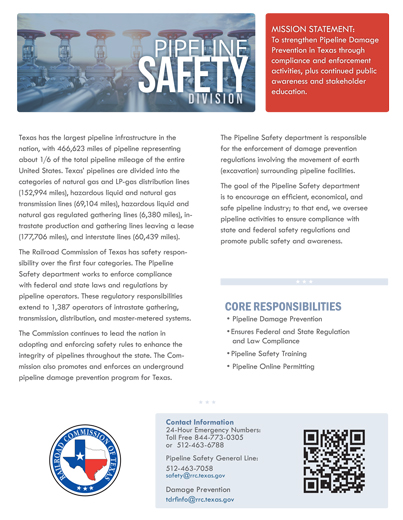
Texas Pipeline Damage Prevention Statistics
- The following PDF
 charts are derived from reports submitted through the Texas Damage Reporting Form.
charts are derived from reports submitted through the Texas Damage Reporting Form. - Damages Per 1000 Locates
- Incidents Per Year
- Top Ten - Root Causes
- Top Ten - Type of Excavator
- Top Ten - Type of Work Performed
- Top Ten - Type of Equipment
Pipeline Safety ANNOUNCEMENTS
Pipeline Mileage Fee Courtesy Notice
November 13, 2024
This courtesy notice from the Railroad Commission of Texas (RRC) is provided to help pipeline operators prepare for the 2025 pipeline mileage fee that is due April 1, 2025. For information about this fee, please reference Texas Natural Resource Code §81.071 and 16 Texas Administrative Code §3.70.
The annual mileage fee is calculated using pipeline permit mapping information supplied by the operators. The pipelines in each permit are divided into Group A and Group B, and the mileage is rounded up to the nearest mile. The sum is used to calculate the annual mileage fee.
The number of miles permitted as of December 31, 2024 will be used to calculate the 2025 pipeline mileage fee. The deadline for payment without incurring late penalties is April 1, 2025 and can be paid through the Pipeline Online Permitting System (POPS) starting on January 1, 2025.
Operators may review the preliminary mileage chart showing their permits for which a fee is owed by visiting the RRC website at https://www.rrc.texas.gov/pipeline-safety/pipeline-fees/ and selecting “Preliminary Mileage Chart - 2025” under “Helpful Links”.
If an operator believes there are errors on the mileage chart, they should submit permit amendments as soon as possible to the RRC to ensure the mileage used to calculate the fee is accurate. Only changes submitted by December 1, 2024 are guaranteed to be corrected before the mileage fees are assessed and the final chart is added to the RRC website on December 31, 2024.
All mileage fees are required to be paid through POPS in the RRC Online System. To view the POPS User Guide, visit the RRC website at https://www.rrc.texas.gov/pipeline-safety/pipeline-fees/ under “Helpful Links”.
Please note that this notice and all future notices will be emailed to pipeline operators using the email addresses on file in POPS. To ensure receipt of important communications from the RRC, pipeline operators must maintain a current email address in POPS.
For additional information, contact the RRC at 512-463-6802 or pops@rrc.texas.gov.
What we do
The Oversight and Safety Division has responsibility for Alternative Fuels, Gas Services and Pipeline Safety. This reorganization in January 2015 will bring even greater efficiency and consistency to these operations within the Commission, allowing the agency to better serve the state.
Texas has the largest pipeline infrastructure in the nation, with 479,798 miles of pipeline representing about 1/6 of the total pipeline mileage of the entire United States. Texas’ pipelines are divided into the categories of natural gas and LP-gas distribution lines (160,860 miles), hazardous liquid and natural gas transmission lines (79,034 miles), hazardous liquid and natural gas regulated gathering lines (8,656 miles), intrastate production and gathering lines leaving a lease (178,963 miles), and interstate lines (52,285 miles). The Railroad Commission of Texas has safety responsibility over the first four categories.
The Pipeline Safety department works to enforce compliance with federal and state laws and regulations by pipeline operators. These regulatory responsibilities extend to 1,458 operators of intrastate gathering, transmission, distribution, and master-metered systems. The Commission continues to lead the nation in adopting and enforcing safety rules to enhance the integrity of pipelines throughout the state.
The Commission also promotes and enforces an underground pipeline damage prevention program for Texas. The Pipeline Safety department is responsible for the enforcement of damage prevention regulations involving the movement of earth (excavation) surrounding pipeline facilities.
The goal of the Pipeline Safety department is to encourage an efficient, economical, and safe pipeline industry; to that end, we oversee pipeline activities to ensure compliance with state and federal safety regulations and promote public safety and awareness.







